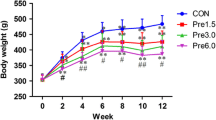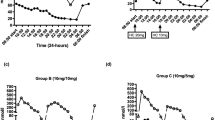Summary
Glucocorticoids adversely affect bone and mineral metabolism through a number of mechanisms, including inhibition of bone formation. Deflazacort is a glucocorticoid which has been reported to be relatively “bone-sparing.” We compared the effects in oophorectomized sheep of deflazacort and prednisolone on the metabolism of osteocalcin (OC), a marker of osteoblast function. An [125I]OC infusion method was used to measure the OC plasma clearance rate (PCR) and OC plasma production rate (PPR).
Six-day intravenous infusion of deflazacort and prednisolone (in the dose range 0.007–1.00 mg/hour) induced dose-dependent decreases in OC PPR which were of a similar pattern but significantly different magnitude (P < 0.02); deflazacort demonstrated a potency about 150% that of prednisolone. Both steroids decreased plasma OC levels on a dose-related basis but at the lower doses 0.05 mg/hour (P < 0.05) and 0.013 mg/hour (P < 0.0005), deflazacort caused greater decrements. OC PCR was significantly increased only by higher doses of deflazacort (1.00 mg/hour, 0.25 mg/hour;P < 0.05). Deflazacort and prednisolone increased both postabsorptive plasma glucose and plasma calcium levels, but there were no significant differences between their effects.
We conclude that plasma OC levels and OC PPR in sheep were more sensitive to the effects of deflazacort than to prednisolone. At high doses, the depressive effect of deflazacort on plasma OC levels may have been due in part to an increased OC PCR which was not evident with prednisolone treatment. However, the agents appeared to have a similar dose-dependent hyperglycemic effect, and both caused a small dose-dependent increase in plasma calcium. These findings indicate that prednisolone had similarly potent effects on both bone and glucose metabolism while deflazacort exhibited differential potency on the two systems. The greater potency of deflazacort on bone in sheep may be due to species differences in steroid metabolism or steroid-receptor interaction.
Similar content being viewed by others
References
Price PA, Partemore JF, Deftos LJ (1980) New biochemical marker for bone Gla-protein in the plasma of normal subjects and patients with bone disease. J Clin Invest 66:878–883
Farrugia W, Yates NA, Fortune CL, McDougall JG, Scoggins BA, Wark JD (1991) The effect of uninephrectomy on OC metabolism: a direct evaluation of renal OC clearance. J Endocrinol 130:213–221
Fortune CL, Farrugia W, Tresham J, Scoggins BA, Wark JD (1989) Hormonal regulation of OC plasma production and clearance in sheep. Endocrinology 124:2785–2790
Ringe JD (1989) Glucocorticoid-induced osteoporosis. Clin Rheumatol 8:109–115
Reid IR (1989)Review: Pathogenesis and treatment of steroid osteoporosis. Clin Endocrinol 30:83–103
Reid IR, Chapman GE, Fraser TRC, Davies AD, Surus AS, Meyer J, Huq NL, Ibbertson HK (1986) Low serum osteocalcin levels in glucocorticoid treated asthmatics. J Clin Endocrinol Metab 62:379–383
Gray RES, Doherty SM, Galloway J, Coulton L, de Broe M, Kanis JA (1991) A double-blind study of deflazacort and prednisolone in patients with chronic inflammatory disorders. Arthritis Rheum 34:287–295
Bruno A, Cavallo-Perin P, Cassader M, Pagano G (1987) Deflazacortvs prednisolone: effect on blood glucose control in insulin-treated diabetics. Arch Intern Med 147:679–680
Schiatti P, Selva D, Barone D, Restelli A, Glasser A (1980) Antiinflammatory activity and other pharmacological properties of 11β,21-dihydroxy-2′-methyl-5′βH-pregna-1,4-dienol [17,16-d] oxazole-3,20-dione-2l-acetate (deflazacort). Arzneimmittelforsch 30(9):1543–1549
Farrugia W, Melick RA (1986) Metabolism of osteocalcin. Calcif Tissue Int 39:234–238
Price PA, Nishimoto SK (1980) Radioimmunoassay for the vitamin-K dependent protein of bone and its discovery in plasma. Proc Natl Acad Sci USA 77:2234–2238
Salacinski PR, McLean C, Sykes JEC, Clemont-Jones W, Lowry PJ (1981) Iodination of proteins, glycoproteins and peptides using a solid phase oxidising agent (Iodogen). Anal Biochem 11:136–146
Tait JF (1963)Review: The use of isotopic steroids for the measurement of production ratesin vivo. J Clin Endocrinol 23:1285–1297
Baker RJ, Nelder JA (1978) The GLIM system, Release 3, Generalised linear interactive modelling. Numeretical Algorithms Group, Oxford, UK
Hahn TJ, Halstead LR, Strates B, Imbimbo B, Baran DT (1980) Comparison of subacute effects of oxazacort and prednisone on mineral metabolism in man. Calcif Tissue Int 31:109–115
Pagano G, Lombardi A, Ferraris GM, Imbimbo B, Cavallo-Perin P (1982) Acute effect of prednisone and deflazacort on glucose tolerance in prediabetic subjects. Eur J Clin Pharmacol 22(6):469–471
Kendall JW, Liddle GW, Federspiel CF, Cornfield J (1963) Dissociation of corticotropin-suppressing activity from the eosinopenic and hyperglycaemic activities of corticosteroid analogues. J Clin Invest 42:396–402
Luzzani F, Glasser A (1981) Differential bindingin vitro to glucocorticoid receptors of deflazacort and prednisolone. Eur J Pharmacol 76:427–430
Assandri A, Ferrari P, Perazzi A, Ripamonti A, Tuan G, Zerilli L (1983) Disposition and metabolism of a new steroidal anti-inflammatory agent, deflazacort, in cynomolgus monkeys. Xenobiotica 13:185–196
Martinelli E, Ferrari P, Ripamonti A, Tuan G, Perazzi A, Assandri A (1979) Metabolism of deflazacort in the rat, dog and man. Drug Metab Dispos 7:335–339
Allessandro A, Antonio P, Giuseppe B, Valeria P (1980) Disposition of a new steroidal anti-inflammatory agent, deflazacort, in rat, dog and man. Eur J Drug Metab Pharmacokinet 5:207–215
Author information
Authors and Affiliations
Rights and permissions
About this article
Cite this article
O'Connell, S.L., Tresham, J., Fortune, C.L. et al. Effects of prednisolone and deflazacort on osteocalcin metabolism in sheep. Calcif Tissue Int 53, 117–121 (1993). https://doi.org/10.1007/BF01321889
Received:
Revised:
Issue Date:
DOI: https://doi.org/10.1007/BF01321889




